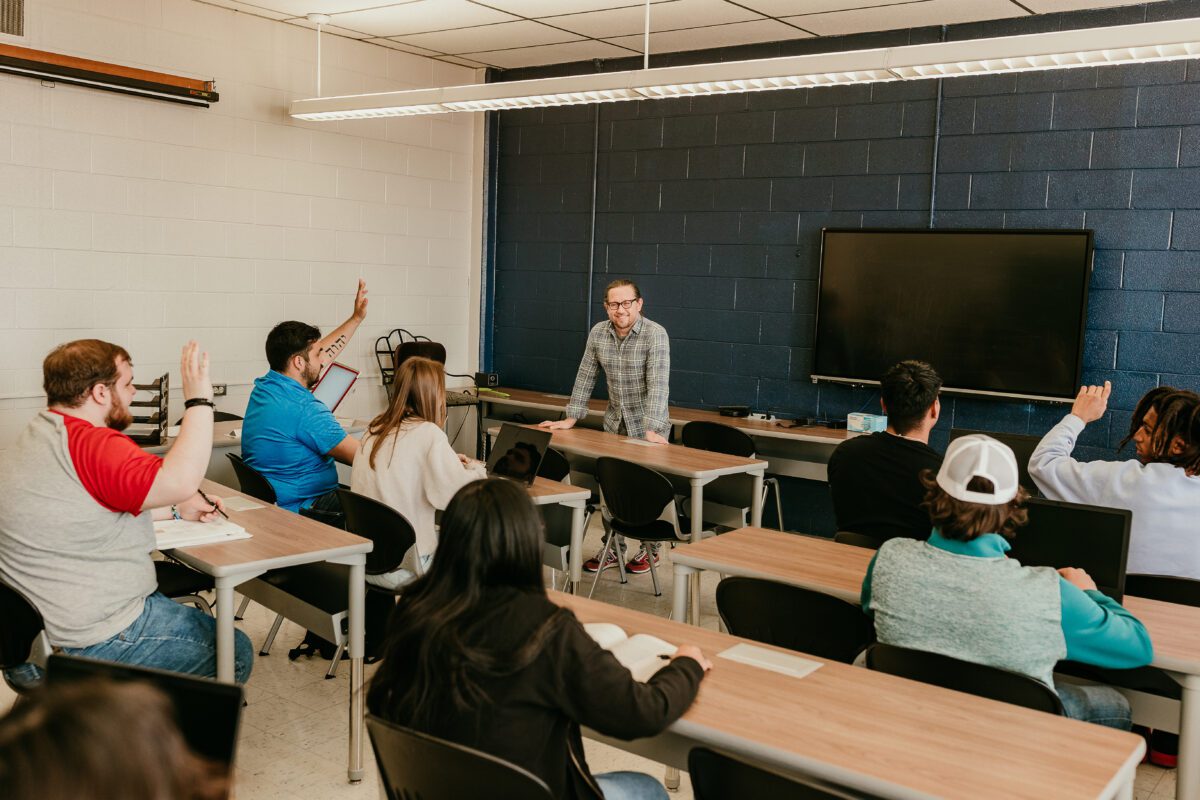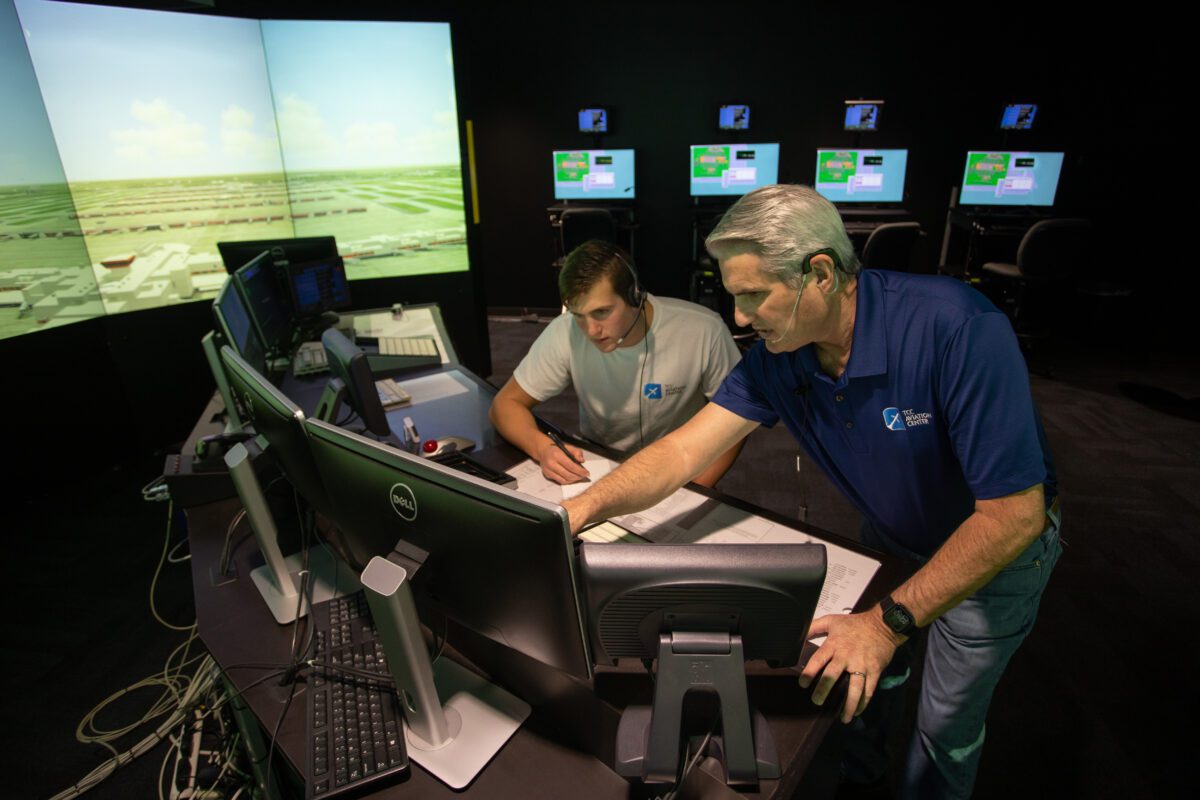Trends in Higher Education
The industry is evolving more quickly than ever, and “it’s a fascinating time to be in education,” says Julie Dinger, Ph.D., the president of Oklahoma Panhandle State University in Goodwell. “We’re in the midst of the biggest culture shifts I’ve ever seen, as there are new, ongoing adaptations to artificial intelligence, a rise in machine learning – and it’s more important than ever for students to be life-long learners.”
Technology is changing rapidly.
“For example, a year ago, our students were encouraged to be prompt engineers, depending on the track they’re on. Fast forward to now, and we’re hosting a conference with the topic: ‘Can AI improve your career?’ where we talk about yes, the threat of AI – the bad stuff like plagiarism – but also how to use it as engaged learning. These fast changes, it’s akin to email when it was new; some professors loved it, some didn’t. Now it’s 30 years later and email is nonnegotiable. I suspect that AI will also become ubiquitous.”
AI tools are prevalent across the state in higher learning institutions, including Tulsa Community College.
“One AI tool we are exploring to use in Career Services is WriteSea, which students use to help create resumes and prepare for job interviews,” says the college’s senior vice president and chief academic officer, Angela Sivadon, Ph.D. “It has a tracking component that allows administrators to monitor student usage and progress within the program. The tool helps to free up valuable time for career counselors to engage in other essential tasks with students.
But artificial intelligence in the classroom isn’t the only trend on the rise; dual credit participation and skills-based training are also gaining traction.
“TCC has seen a surge in high school students dually enrolled in our programs in the last few years,” says Sivadon. “We’re the largest provider of dual credit degrees in the state, and we offer dual credit programs to 13 school districts. It reflects a growing interest among students to engage in college learning early, giving them a head start on post-secondary education. We’re also seeing a shift in how students are obtaining an education, often stacking credentials and experience from different places, rather than from a single institution. Students are seeking a mix in skills-based training and experiential learning, like internships or apprenticeships. It shows students value interactive educational experiences.”
Gamification in learning continues to gain traction and is a great way for educators to increase student engagement.
“Gamification can help create a more collaborative, student-centered approach to learning in the classroom and can help students build relationships with each other and their instructors through teamwork, competition, shared goals, micro-learning and increased participation,” says Mautra Staley Jones, Ed.D., president of Oklahoma City Community College. “Additionally, gamifying education appeals particularly to Gen Z students who are typically more comfortable with technology and digital games to help keep them stay actively engaged in the learning process.”
Accessibility: Micro-Credentials, Workforce Certificates and Badges
Micro-credentials – short, focused credentials designed to provide in-demand skills – are helping to keep education accessible to more people. This also helps in meeting specific needs of employers in the state.
“NSU has been, and will continue to be, fully engaged in providing the education needed in our current workforce, which includes micro-credentials, certificates and badges,” says university president Rodney Hanley, Ph.D. “We have spent the last few years finding ways to stack credentials to help move students towards a degree while also obtaining the education they need in their current job or career goals. We are also serving businesses in the area by developing new pathways to help meet the critical occupations in Oklahoma, while streamlining our processes and systems to help make this easier for students wanting a different kind of education and serving our businesses in the area.”
At TCC, workforce certificate programs run the gamut, “from cybersecurity to EMT training to childcare,” says Sivadon. “Micro-credentials offer flexibility to students who may not have the resources to obtain an associate or bachelor’s degree. Credentials allow them to tailor their education to their specific needs and circumstances. Micro-credentialing shows the importance of short-term goals for students. When students complete a micro-credential, they’re more likely to pursue the next educational milestone.”
Staley Jones adds: “The time invested in earning a degree at any level is extensive and often is cited as a barrier to education. OCCC has been a pioneer in Oklahoma in both offering and awarding micro-credentials. Most of our micro-credentials were born from partnerships with our industry-informed advisory boards and the feedback we received demanding skills needed immediately in the workforce. We analyzed our course offerings within our programs and grouped specific courses together to train those skills needed to fill gaps in the workforce.”

A Look at the Stats
As of 2023, Oklahoma is still ranked 45th in education, a ranking that measures both educational attainment and the quality of education. There are myriad factors as to why the state has this ranking, and institutions are working to better our numbers, one initiative at a time.
“Oklahoma’s educational ranking serves as a catalyst for transformative action and innovation within our educational institutions,” says Staley Jones. “Factors influencing this ranking include historical educational funding levels, teacher retention rates and access to advanced educational resources. However, the accurate measure of our progress lies in the proactive steps being taken to enhance our educational landscape.”
Oklahoma State University is working diligently to alter those rankings.
“We’re focused on providing the best possible education for our students, preparing them to shape fulfilling careers and make a meaningful impact as problem solvers and community builders,” says provost Jeanette Mendez, Ph.D. “In the fall of 2022, we unveiled the We Are Land-Grant strategic plan, which includes a mandate to take a student-focused approach as we strive to cement OSU as the nation’s preeminent land-grant institution. A key component of that plan is expanding educational access. We aim to recruit an increasing number of college-ready undergraduate students, increase scholarship support for students and work to reduce student debt with specific, measurable targets.”
But the plan doesn’t just benefit college students.
“On the K-12 side, we are working hard with our partners at the Oklahoma State Regents for Higher Education to recruit and train teachers, designing innovative approaches to training like the OSUTeach program, finding financial incentives for students both from OSU funds and State Regents programs, and providing crucial early career support for teachers through programs like OK-Thrive and continuing professional development for teachers,” says Mendez.
Challenges in 2024 in Beyond
Hurdles for education include the need for continual learning surrounding advanced digital platforms in our hybrid education space, as well as the human circumstances of teacher, student and administration burnout. Educators are meeting these challenges with innovation.
“Education and higher education are changing at a rapid pace,” says NSU’s Hanley. “It is always difficult, regardless of the sector, to constantly evolve and change to meet the changing needs and dynamics. Higher education is certainly no exception to that as we seek to raise salaries, quality and innovation while maintaining and even lowering costs. There is great discourse about the varying opinions on how to manage and respond to this changing landscape. It is no simple task for higher education leaders, and every institution is managing that differently.”
The uses – and potential abuses – of artificial intelligence continue to both vex and inspire education leaders.
“AI is obviously something we have to adapt to,” says OSU’s Mendez. “Instructors will change their methods of assessment, and the new technology provides a good opportunity to evaluate what our students need to know when they graduate from college. A favorite method along these lines: Instead of just asking students to do a list of math problems, give them a problem and a common incorrect answer, and ask how a student might have arrived at this wrong answer – or how a typo might have caused a computer to give “wrong” output.”
The projected enrollment cliff – the dramatic drop in the college-age population beginning in 2025 – poses the challenge of “how to stay relevant when national higher education enrollment numbers are on the decline,” says TCC’s Sivadon. “We are focusing on our workforce skills training programs and emphasizing practical skills that students can directly apply to their careers. Ensuring transfer to a four-year institution is seamless for students and that they are prepared to complete their bachelor’s degree is essential in meeting their career goals. We can also promote post-secondary education for students by connecting with them early in high school. Helping them develop a college mindset can motivate them to pursue higher education and to better understand the possibilities post-secondary education can provide.
Remaining relevant to the current workforce and its needs is also a challenge.
“It’s critical our curriculum aligns with career fields that are changing rapidly due to technology, such as in STEM and healthcare sectors,” says Sivadon. “We work proactively with employers through advisory councils to understand their evolving needs so we can provide students with relevant skills and technology.”
Preparing Students
Higher learning professionals are charged with preparing students for post-college life – not only in educational benchmarks but in soft skills like collaboration and strategic communication.

“Helping individuals, families and communities recognize the power of higher education is a continuous challenge,” says Jerrid Freeman, Ed.D., NSU’s vice president for student affairs and enrollment management. “A college education has the ability to change the trajectory of lives for generations, and this is something we see year after year at NSU. The world is changing, though, and we must keep up to ensure students receive the support and training they need. For NSU, this means providing programs in flexible formats – with many being completely online – offering micro-credentials and certificates and maintaining partnerships with businesses and other institutions to ensure a better life for our graduates and our state.”
The University of Oklahoma places an emphasis on smart strategy when preparing their students for life after college.

“At the heart of OU’s ‘Lead On, University’ Strategic Plan is our fundamental purpose – we change lives,” says a rep from OU. “To that end, the university provides a holistic education, ensuring students acquire the foundational knowledge and skills necessary for personal growth and responsible citizenship. Our tailored educational pathway is designed to empower students as future leaders, enabling them to navigate the intricacies of the world with respect and dignity for all. The university also recognizes that the development of soft skills is an important part of a student’s education. At OU, many of these skills are taught as part of our general education curriculum.”
At OSU, student requirements aren’t just ticks in a box.
“Our goal is for students to be career ready, and that is not just a matter of completing a specified number of courses in specific areas,” says Mendez. “We are taking steps to ensure our graduates exhibit four competencies: professional preparedness, engaged citizenship, ethical leadership and personal responsibility.”
At OCCC, that mission is also taken seriously.
“It is absolutely the responsibility of higher education learning professionals to arm our students with as much knowledge as possible to set them up for success,” says Staley Jones. “And any failure to do so is a huge disservice to not only those we serve, but also those who depend on them.”
Financial Aid, Scholarships and Educational Access
College tuition, along with just about everything else, has risen exponentially over the last 5-10 years. Colleges are working to combat inflation while maintaining high benchmark standards.

Oklahoma Panhandle was recently ranked by Third Way International as a No. 1 college for Economic Mobility – the highest rating possible, says Dinger. She says this emphasis on accessibility will continue.
“Accessibility is foundational in our conversations each year as we work to set the budget,” says NSU’s Freeman. “We know the students we serve, and we want to do everything we can to help higher education at NSU be possible. We not only work to make our tuition financially feasible, but we will continue to grow our scholarships and ways to assist those who need the financial support. NSU also makes great efforts to provide courses and programs in online formats to meet the needs of working students.”
OSU efforts to help students financially is part of what defines the school itself.
“Accessibility is part of our mission as a land-grant university,” says Mendez. “In June 2023, the OSU A&M Board of Regents approved the 2024 budget with tuition and mandatory fees remaining flat for the second straight year. Within the strategy are specific plans to increase student access, affordability, retention and enrollment.”
At TCC, resources are ample for current and prospective students.
“TCC remains affordable through our competitive tuition rates and the Tulsa Achieves program, which provides tuition assistance to Tulsa County students,” says Sivadon. “We also provide tuition waivers for up to 27 hours for high school students for dual credit. Scholarships funded by the TCC Foundation, offered annually, contribute to the financial support of students pursuing their academic goals. We know these measures work because more than 70 percent of our students leave TCC debt-free.

Even better, TCC’s affordability “also extends to resources,” says Sivadon. “As inflation drives up the prices of textbooks, we’re utilizing open educational resources, like free online books and materials. We have faculty members who are contributing to open educational resources and having access to these lifts the financial burden of expensive textbooks.”
At OU, the team understands how big an investment a college degree is – and leadership works to make that investment worthwhile.
“OU students are surrounded by opportunities to gain valuable, real-world experiences that make their OU degree worth the investment. [We] offer an extensive alumni network around the world and a Career Center office that aids students with everything from resume building to mock interviews to on-campus career fairs,” says a rep from OU. “To help with the cost of higher education, our No. 1 fundraising priority is to increase the availability of need-based aid, so that students who can succeed and excel can do so at OU. Plus, OU’s Crimson Commitment program, which began in 2018, also provides qualified Oklahoma’s Promise students with up to $9,085 to cover annual fees and 100% of tuition.”






















